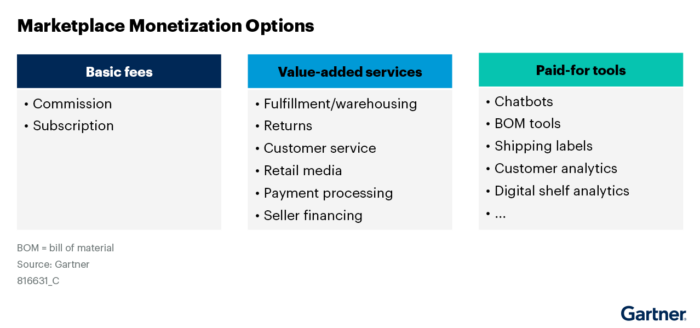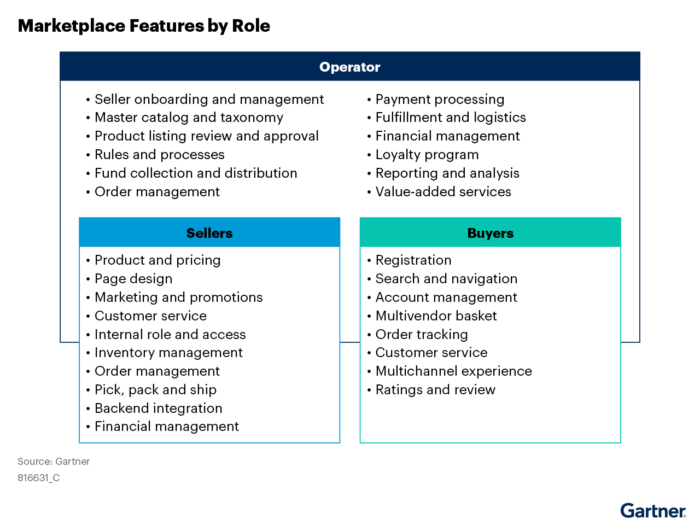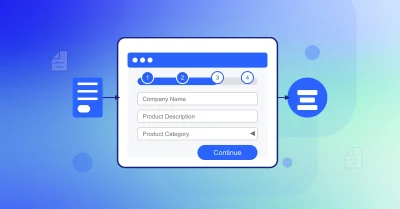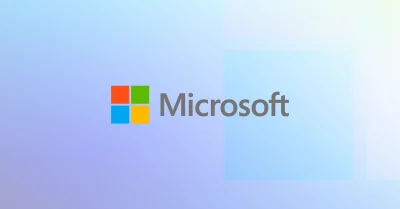Laying the Foundation
Building a competitive enterprise marketplace is an exciting yet challenging journey. Unlike traditional eCommerce, a SaaS marketplace goes beyond simple transactions; it’s a platform for delivering software, services, and solutions that evolve with business needs.
Creating a marketplace that stands out in today’s crowded digital landscape requires a clear focus and a well-defined value proposition. Establishing this foundation is crucial, as it informs all strategic decisions, ensuring the marketplace is aligned with long-term goals.
In this guide, we’ll dive into the five key elements essential for building a competitive enterprise marketplace: architecture, monetization, user experience, scalability, and partnerships.
By focusing on these elements, you can create a dynamic ecosystem that drives revenue growth, strengthens vendor relationships, and offers users a valuable and engaging experience.
Architecture
The architecture of an enterprise marketplace is the structural core that powers the entire platform. Building a marketplace that’s both flexible and scalable starts with choosing the right foundation and ensuring that each component can work seamlessly with the others. For a marketplace, two architectural pillars are essential: a core infrastructure and a robust API layer.
Core Infrastructure
At the heart of a successful marketplace is a robust, cloud-native, and scalable infrastructure that can easily adapt to changing demands. Opting for a cloud-native foundation ensures that your marketplace can dynamically scale up or down as needed, supporting high availability, and reducing the risk of downtime.
When selecting the right platform, look for one that allows flexibility in essential functions—like user management, catalog management, and order processing. A well-architected platform will enable you to update or enhance individual functions independently, providing the agility to respond quickly to user needs and market demands. This approach supports efficient deployment of new features, ensuring your marketplace stays competitive and responsive without the need for extensive, system-wide adjustments.
API Layer
A strong API layer is critical for connecting your marketplace to external systems and adding flexibility for future growth. APIs allow third-party applications—such as payment processors, analytics tools, and customer support systems—to integrate with your platform in a standardized way, which reduces development time and complexity.
When choosing an API management solution, prioritize options that offer scalability, high security, and flexible protocol support, such as REST or GraphQL. This enables smooth data exchange across various components and lets you integrate new tools or features with minimal disruption. Look for features like rate limiting, access control, and monitoring, which can help manage API usage efficiently and protect the marketplace from misuse or overload.
Consider using an API gateway to manage and control all API traffic. An API gateway acts as a centralized entry point, handling tasks like routing, authentication, and load balancing. This setup allows you to manage integrations in a secure, organized way and simplifies the process of adding or updating services as your marketplace evolves.
Monetization
Monetization is the backbone of any successful enterprise marketplace. To drive sustainable revenue and stay competitive, your marketplace should incorporate a strategic blend of monetization approaches that suit various SaaS products, services, and partnerships.
Recurring Subscriptions
Offering recurring subscriptions is the standard strategy for monetizing an enterprise marketplace, as it provides steady and predictable revenue. By allowing customers to subscribe to individual SaaS products or bundled services, you create options for businesses that value ongoing access to critical tools and prefer flexibility over one-time purchases.
Subscription packages can be tailored to offer monthly, quarterly, or annual plans, with incentives like discounts for longer commitments. This model not only fosters customer loyalty but also establishes your marketplace as a reliable, go-to resource for businesses seeking consistent, long-term software solutions.
Reseller Partnerships
Reseller partnerships enable your marketplace to reach new customers by leveraging the networks and expertise of resellers. By allowing resellers to sell your SaaS products, you extend your marketplace’s reach into new markets and verticals.
Resellers can also bundle your products with their own offerings, adding unique value for their customers while generating additional revenue for your marketplace. A structured reseller program with incentives for high-performing partners can drive significant growth and boost marketplace visibility.

Hyperscalers
Partnering with major hyperscalers like AWS, Microsoft Azure, or Google Cloud opens doors to a broader market. Integrating your SaaS products with these established cloud platforms enables enterprise customers to adopt your solutions within their trusted cloud ecosystems.
These partnerships not only expand your marketplace’s visibility but also attract customers who prioritize seamless integration with their existing environments. By being available on hyperscaler marketplaces, you can tap into new revenue streams and benefit from the trust that these cloud giants have already established with their users.
User Experience
User experience (UX) is a defining factor for any successful enterprise marketplace. The smoother and more intuitive the experience, the more likely users are to stay engaged, complete purchases, and return for future transactions. In a competitive marketplace environment, UX goes beyond aesthetics—it’s about making every interaction feel seamless, purposeful, and easy for all users, whether they’re buyers, sellers, or administrators.
Intuitive Navigation and Design
A well-designed marketplace should make it effortless for users to find what they need, from browsing products to completing transactions. Clear categories, effective search functions, and simple navigation paths are crucial. This is especially important for enterprise users who may need to manage large volumes of products or services. Thoughtful design choices, like prioritizing frequently used functions and minimizing the steps needed for complex actions, contribute to a smooth, productive experience that respects the user’s time.
Personalized Experiences
Personalization can make an enterprise marketplace stand out by delivering experiences tailored to individual user needs. This might include showing recommended products based on a user’s purchase history, sending notifications for new releases in relevant categories, or creating customized dashboards that highlight key information. By understanding the preferences and behaviors of different users, you can create a marketplace that feels personalized and relevant, encouraging users to stay engaged and explore new offerings.
Streamlined Onboarding
An efficient onboarding process is vital for keeping new users engaged and getting them comfortable within the platform. For resellers, onboarding should simplify listing products, managing inventory, and integrating with existing business systems. Buyers, on the other hand, benefit from guided tours, tooltips, or even tutorials that quickly introduce them to the platform features. By making onboarding fast and intuitive, you help users of all experience levels gain confidence and start using the enterprise features effectively.
Scalability
Scalability is crucial for any enterprise marketplace that aims for long-term success. As your marketplace grows, so does the number of users, transactions, and data requirements. To keep up with these demands, your platform must be built to handle growth efficiently, without compromising on performance or user experience. Choosing a marketplace platform that supports scalable architecture is essential to support increased traffic, product offerings, and revenue.
Flexible Infrastructure
An enterprise marketplace needs a solid infrastructure that can adapt to increasing demand. Look for platforms that offer cloud-based scalability, allowing you to expand server capacity as needed without affecting performance. This ensures that, as your user base grows and more transactions occur simultaneously, your marketplace continues to operate smoothly. Cloud infrastructure also makes it easier to manage peak traffic periods, such as new product launches or promotional sales, without risking slowdowns or downtime.
Automation
Scaling your marketplace isn’t just about supporting more users; it’s also about optimizing workflows to manage growth efficiently. Automated onboarding for resellers, payment processing, order management, and product catalog updates can significantly reduce manual workloads. Automations help your team maintain high-quality service even as transactions and user activity increase, ensuring that operations are streamlined and that the marketplace can handle more sellers and buyers without overwhelming your resources.
Advanced Analytics
Effective scalability is also about maximizing revenue growth alongside user growth. Advanced analytics tools help you identify trends, monitor performance, and optimize pricing and offerings as your marketplace expands. Look for platforms with built-in analytics or the ability to integrate with third-party tools. By tracking user behavior, sales trends, and revenue patterns, you can make data-driven decisions that enhance profitability and keep your marketplace competitive.
Partnerships
Building strong partnerships is one of the most impactful ways to establish and grow a competitive enterprise marketplace. Success in the marketplace depends not only on having great products but also on fostering relationships with the ecosystem around those products. By developing strategic partnerships with customers, resellers, and software vendors, your marketplace can leverage a wide network that drives engagement, revenue, and long-term growth.
Customer Engagement
Your customers are at the heart of your enterprise marketplace, and creating a strong relationship with them is essential. Focus on understanding their needs and preferences, and tailor your offerings accordingly. Regular communication, feedback loops, and personalized experiences all play a role in building trust and loyalty. This could include implementing customer success initiatives, offering dedicated support, and providing tools or resources that empower them to get the most value from your marketplace. A customer-centric approach not only increases satisfaction but also encourages long-term retention and positive word-of-mouth, which can attract new users.
Reseller Networks
Resellers can extend your marketplace’s reach, helping you tap into new customer segments and increase revenue streams. To build successful reseller partnerships, ensure your marketplace platform is reseller-friendly, with clear onboarding processes, competitive pricing structures, and tools that make it easy for them to manage their own customers within the marketplace. Providing resources such as marketing support, training, and co-selling opportunities can further empower your resellers to succeed. Strong reseller partnerships enable you to scale quickly, reach diverse markets, and build a more robust presence without directly handling all sales activities yourself.

Vendor Collaboration
Bringing software vendors into your marketplace creates a rich ecosystem of complementary solutions that can meet a broad range of customer needs. A successful marketplace should allow vendors to list, market, and manage their own products while adhering to your platform’s quality standards. This collaboration benefits all parties: customers gain access to a diverse selection of trusted tools, vendors expand their market access, and your marketplace becomes a comprehensive destination for software solutions. Working closely with vendors to ensure smooth integration, clear communication, and mutually beneficial business terms will strengthen these relationships and keep the marketplace vibrant.
Key Takeaways
Launching a competitive enterprise marketplace is a multifaceted journey that requires thoughtful planning and a strategic approach. By focusing on the five key elements—architecture, monetization, user experience, scalability, and partnerships—you can build a robust platform that not only attracts customers but also supports long-term growth.
A strong marketplace architecture lays the groundwork, enabling smooth integrations and reliable functionality for all stakeholders. Effective monetization strategies ensure that your marketplace generates revenue in ways that align with customer needs, whether through recurring subscriptions, reseller partnerships, or value-added services. User experience plays a critical role, making sure that both buyers and sellers find your platform easy, engaging, and intuitive to use. Scalability allows your marketplace to grow seamlessly, accommodating increasing volumes of transactions and users while maintaining performance. Finally, partnerships with customers, resellers, and software vendors help create a dynamic ecosystem, expanding your marketplace’s reach and capabilities.
With these core elements in place, your enterprise marketplace can thrive, delivering value to your users and positioning itself as a key player in the digital commerce landscape.












